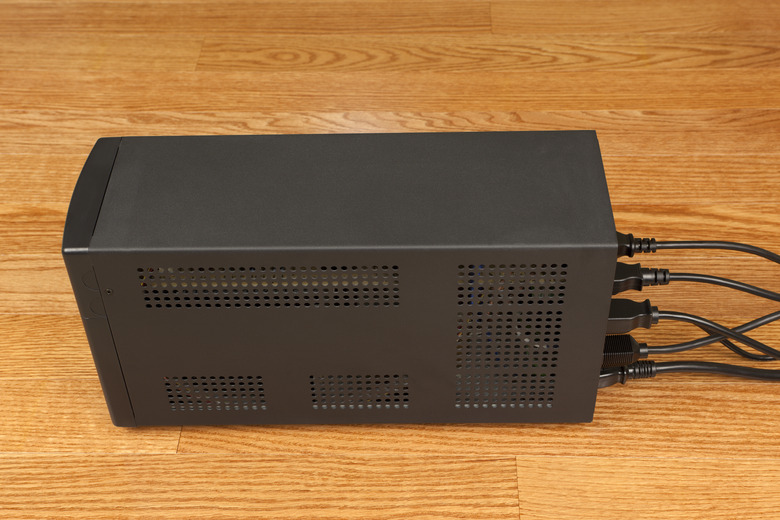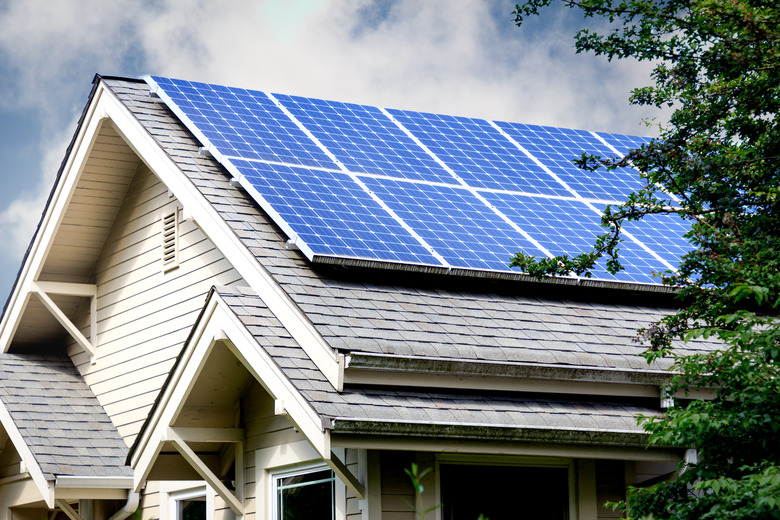What Are UPS Battery Backup Systems? Learn About This Handy Tool For Power Outages
A power outage is usually a minor inconvenience — a frustration when you're working at a computer and lose all of your work — but it can also have devastating consequences when it's prolonged. That's why it's always a good idea to have some sort of backup power, whether it be in the form of a backup generator to help you power all of your home's systems or a UPS (uninterruptible power supply) battery backup system to prevent damage to your home electronics. Even if you lose electrical power, a UPS battery backup system will keep your computer (or other devices) running long enough to safely shut down the system.
In its simplest form, the battery backup power kicks in almost instantaneously as the power goes out, and the time lag is so short that it won't affect what is on the screen. The battery will supply power to the device for a few minutes, although times vary based on the size of the battery and the manufacturer.
While all UPS battery backup systems buy time to safely shut down your device, some types of UPS systems also clean up the electrical energy that reaches your computer and other electronic devices. That's sometimes necessary because electricity can vary in quality in the form of voltage drops, voltage spikes and other problems. Those changes in power quality can harm some electronic components, so it's a perfect addition to any smart home.
Tip
A UPS battery backup system can supply power to electronic devices like computers when there is a power outage. They prevent a loss of data on your computer (or other devices) and can act as chargers in case the power takes several hours to come back on. There are even UPS battery backup systems on the market that can power your home's systems if there's a prolonged power outage.
Do You Need Battery Backup?
Do You Need Battery Backup?
Many people work at home at least part time. Losing important data or information because of a hurricane, tornado or some other type of storm can be devastating if your power goes out. Having a backup power system can also help you charge your phone, which can give you peace of mind in any emergency.
A UPS battery backup can also protect game consoles, routers, monitors, modems, smart TVs, audio equipment and just about any electronic device that requires clean energy to operate efficiently. Electricity that is less than perfect can cause components to wear out quickly and interfere with how the product operates, producing fuzzy images, background noise and the like.
There are many electrical abnormalities to which most of us pay little attention, but they can cause damage to electronics. For example, a power surge is usually caused by a lightning strike, and the spike in power can harm electronics. A brownout is a drop in available power when there is more demand than usual. Sometimes, utility companies will reduce the amount of power to avoid overtaxing the power grid. Voltage sags and voltage spikes can occur for a number of reasons. They are usually brief and not as evident as brownouts or surges, but they can still cause damage.
A surge protector can handle some electrical problems but not all. A home battery backup system can protect against both total blackouts and fluctuations of incoming power.
UPS Battery Backup Technologies
UPS Battery Backup Technologies
There are three configurations for UPS battery backup systems. They all come in different capacities, or the size of the electrical load they can protect.
Standby systems, as the name implies, sit idle until they are needed. If the power goes out or if the line voltage falls or rises beyond acceptable levels, the unit switches to battery power. Batteries produce DC, or direct current, but the units contain an inverter that changes the DC to AC, or alternating current. Your home runs on AC electricity, and this is the type of electricity that home appliances use. Standby systems are considered entry-level products.
For greater protection, many people rely on line-interactive systems. These systems have the ability to correct minor fluctuations in the incoming power without switching to battery operation, which saves battery life. The batteries on all UPS systems will eventually need to be replaced, but these systems can boost low voltages and suppress high voltages within certain limits. Line-interactive systems are a good choice for most home electronics, including video and sophisticated sound systems.
The highest level of protection is offered by double-conversion, or online, systems. These systems provide the cleanest power possible. They do it by taking incoming AC power from the home and switching it to DC power and then back to AC. So, the battery is always providing power to the electronics while the home's incoming electrical system recharges the battery. Large versions of this type of battery backup are used to protect telecom installations, data centers and large-scale computer servers.
UPS Battery Backup Types
UPS Battery Backup Types
As with computers, UPS battery backup systems come in different sizes and configurations. Some standby systems look like surge protectors that can be placed on top of a desk or on the floor. Others are larger, towerlike appliances that are best placed on the floor.
They all contain a number of receptacles where you plug in your electronics. The system itself gets plugged into a standard electrical outlet. That means you may need multiple units, such as one to protect computer equipment in a home office and another to cover the electronics in a home theater.
Many backup units contain a few receptacles that provide surge protection only, not UPS battery backup. That allows the manufacturer to provide a large number of receptacles while keeping the size of the backup battery small. Ultimately, it's the battery's size and capacity that affects the price of the unit.
In addition to receptacles, there may be USB charging ports so that the system can communicate with your computer as well as jacks for telephone connections. Some systems have LED displays that track the battery's strength and charge as well as the condition of the incoming electricity. Many manufacturers offer software that can automatically and safely shut down a computer or other device if there is an outage, and you are away from your desk.
Choosing a Battery Backup System
Choosing a Battery Backup System
When deciding which UPS technology they want to use, most homeowners find that either a standby or line-interactive system will suit their needs. It's best to choose a specific product based on its capacity and the number of receptacles. Just remember that some of the receptacles will offer surge protection only.
To ensure that you don't overload the UPS, add up the watts your equipment consumes and match it to the capacity of the unit you are considering. If you are backing up a computer, don't forget to include items like the monitor and external hard drive in your calculations. To be safe, the wattage of your equipment should be about 20 percent less than the capacity of the battery backup.
You may find the number of watts a product consumes listed on the product. Some products list the amps the product requires. You can multiply amps by line voltage to determine the number of watts. So, 3 amps multiplied by 120 line voltage means the unit will use 360 watts.
You will also want to consider how long the backup battery power will last. Because the systems are designed to provide enough time to save your work and then safely shut down the system, the battery will run out of juice in a few minutes. A five- to 10-minute life is typical.
Manufacturers will usually list run time for a full load and a half load. The less wattage the battery needs to provide, the longer it will last. Some companies list the full load time and a time for providing a low number of watts, such as 100 watts.
You can boost the UPS run time by hooking it up to an external battery pack. Although you can find videos online of people attaching car batteries to UPS systems, it is not recommended, and it is probably dangerous. The companies that sell UPS systems also manufacture the add-on battery packs. Usually, the packs will work only with specific UPS systems.
Battery Backup Waves
Battery Backup Waves
If you could picture AC electrical power, it would look like a symmetrical wave where the peaks and valleys are equal. It is called a sine wave. UPS battery backup systems produce sine waves, but some produce pure sine waves, while others produce modified waves. Modified sine waves are not as smooth as pure waves. They are blocky and more stairlike than rounded pure sine waves.
For many electronics, that is not a problem, but some work best with pure sine waves. Computers that contain PFC — or power factor correction, which is a feature that helps the computer and other devices use incoming electricity more efficiently — work best on pure sine wave power. Most ENERGY STAR products work best with pure sine waves.
Most electronics will still work on modified sine waves, but there may be some distortion. TVs and monitors may have fuzzy pictures, and speakers may buzz. Medical equipment, such as heart monitors, require pure sine waves to work properly, so be sure to consider that when you are shopping for your unit.
Solar and Battery Backup
Solar and Battery Backup
Most homeowners who have a solar array on their home remain connected to the electric grid. Their solar panels produce energy they can use and also energy they can feed back to the electric utility. In these cases, a UPS battery backup would work just like it works for nonsolar houses.
Grid-connected solar systems shut down when there is a utility blackout. That is necessary because electricity travels in a circuit; it travels from the generating station to your house and then back to the generating station. If electricity generated by the solar panels finds its way back onto the grid, it could harm people working to repair the electrical lines that they think are without power.
Solar systems that are connected to the grid but also have battery backup for the solar system may benefit from UPS technology. In most cases, the UPS backup will click on when the utility power fails, after which the homeowner can switch to battery power.
UPS Battery Backup for the Entire Home
UPS Battery Backup for the Entire Home
Homes that use solar energy that are off-grid rely on a bank of batteries that stores the renewable electricity for use in the house. These types of batteries are becoming more efficient and more sophisticated as solar systems become more popular, and some manufacturers are marketing the batteries for use with backup systems in homes that have grid-tied solar systems or even no solar power at all.
Tesla's — yes that Tesla — Powerwall battery is one such product that can be used with or without solar panels (though it's only for sale alongside their solar panels currently). These lithium-ion batteries can be charged by solar panels or by utility-supplied electricity. When the power goes out, the Tesla Powerwall switches on. Each battery has an energy capacity (the amount of power stored in the battery when it is fully charged) of 13.5 kWh (kilowatt-hours) with a 5kW power rating, which is the electrical power it can deliver at any one time. They produce a pure sine wave.
Considering the average home consumes about 28 to 29 kWh per day, a single battery can provide power for 10 to 12 hours. If only essential systems were used in the home, the power would last longer. Also, up to 10 Powerwalls can be combined into a single system.
The batteries can be floor- or wall-mounted, and they look fairly sleek and stylish. They are monitored and controlled through an app on a smartphone. Although this product is handy, expect to pay up: installation of one battery ranges from $12,000 to $15,000.
References
- CyberPower: Choosing a UPS System 101: The Fundamentals
- Tripp Lite: UPS Battery Backup Buying Guide
- TechHive: Uninterruptible Power Supply Buyers Guide
- Go Solar: Using an Uninterruptible Power Supply (UPS) with Solar
- FS: Confusion Resolved: UPS vs Battery Backup Differences
- Tesla: Powerwall
- Rise: Tesla Powerwall 2 – 2020 Buyers Guide
- EnergySage: The Tesla Powerwall Home Battery Complete Review


